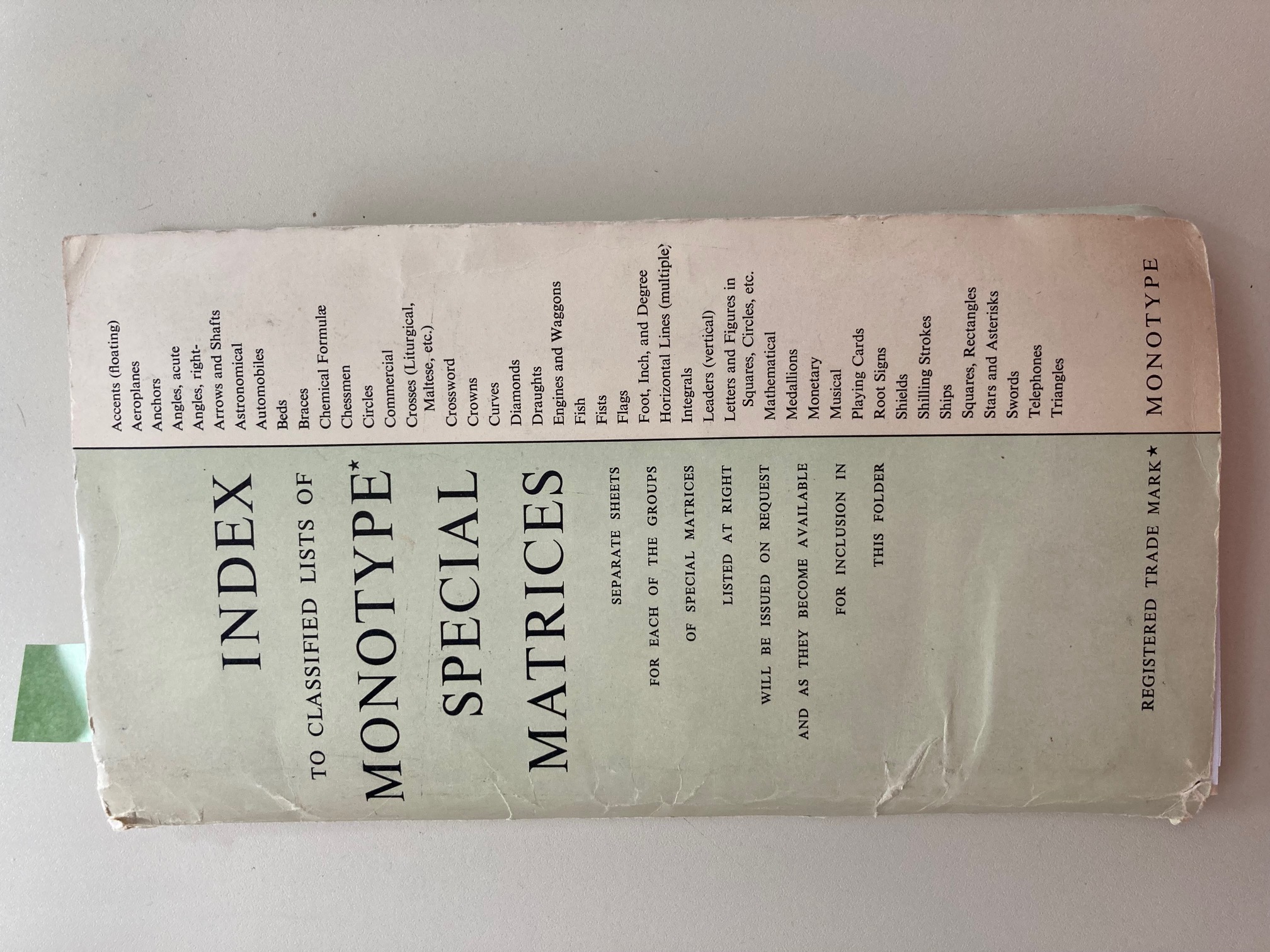
Part 1: U+237C ⍼ RIGHT ANGLE WITH DOWNWARDS ZIGZAG ARROW
Part 2: update: U+237C ⍼ angzarr;
Part 3: Monotype Mathematical Sorts
This is part 4.
Many thanks to Sallie Morris at the Science Museum Group, Claire Welford-Elkin at St Bride Library, and Brian Corrigan for their help.
This update was originally posted on cohost.
Back when I first found the physical punch in the Science Museum Group’s collections, I emailed them to see if they might know anything more. I received a reply earlier this year from their typography collections project curator, Dr. Sallie Morris, who sent back photos of ⍼ appearing before the 1972 series L231 as S16139! The photos are of an “Arrows & Shafts” booklet from Index to Classified Lists of Monotype Special Matrices, dated October 1966, which contains a variety of other booklets as well. You can see ⍼ in the rightmost photo near the middle of the rightmost column, listed as S9576.
 Index to classified lists of Monotype special matrices
Index to classified lists of Monotype special matrices
.jpg) Front cover of Arrows & Shafts booklet, dated 10-66
Front cover of Arrows & Shafts booklet, dated 10-66
 interior.jpg) Interior of Arrows & Shafts
Interior of Arrows & Shafts
Morris was able to consult a former colleague from the Type Archive who had actually worked at Monotype during this period.
I consulted a former Monotype employee yesterday. (He started work for Monotype in Surrey in 1945 and continued to work at Monotype with hot-metal technology until 1992 after which he seamlessly continued to work with Monotype matrices at The Type Archive in London until 2022.) I asked why Monotype designed and manufactured so many signs and symbols that were so similar to each other. It was driven by customer requests (or the customer’s customer request). If a customer asked for an arrow or a company logo, for example, Monotype would make it. Perhaps the customer was not shown the range of existing arrows to see if one would be suitable.
It’s unclear, then, whether ⍼ was significant enough to be requested twice, or if it had been relisted in L231 for other reasons. This still doesn’t explain who had requested the glyph, or why it had been requested. In fact, there are a lot of other interesting and obscure arrows in this booklet with no clear reason for their existence, like the three below. Who knows how glyphs were selected for L231, which would later become a source of codepoints for SGML.


 S4182
S4253
S4521
S4182
S4253
S4521
While searching for more information on this Index, I found that the Morison Collection also has a copy listed under Morison.MC.Q17, so I once again contacted them and was sent back photos of their “Arrows & Shafts” booklet, dated December 1954, which at this point looks more like a brochure. The list stops at S9198 and appears to include all signs up to that point in the 1966 booklet.
 front.jpg) Front page of Arrows & Shafts, dated 12-54
Front page of Arrows & Shafts, dated 12-54
 back.jpg) Back page of Arrows & Shafts
Back page of Arrows & Shafts
I also found a Brian Corrigan selling a copy of the Index, so I asked for some photos of “Arrows & Shafts” as well, which they were kind enough to provide. The booklet is dated January 1963 and looks to be the same as the 1966 edition.
.jpg) Front cover of Arrows & Shafts booklet, dated 1-63
Front cover of Arrows & Shafts booklet, dated 1-63
 interior.jpg) Interior of Arrows & Shafts
Interior of Arrows & Shafts
The earliest verifiable appearance of ⍼ is then January 1963, and must have been created in the eight-year period between then and December 1954.


